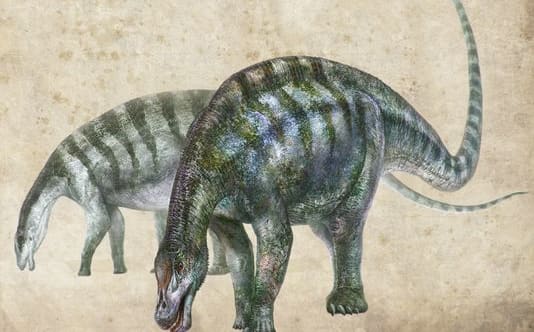The discovery of a new Chinese species of sauropod named the "amazing dragon of Lingwu" pushes the appearance of advanced sauropods back by 15 million years.

An artist's rendering of Lingwulong shenqi, a new species of dinosaur discovered in China. Photo: Zhang Zongda
And that's not all - not only is it the oldest member of this group to be found, but it's the first ever from Asia.
Paul Upchurch is a Professor of Palaeobiology, at the Department of Earth Sciences, at University College London.
He says the dinosaur, Lingwulong shenqi, was not as big as other members of the neosauropod group.
"Basically everyone knows animals like diplodocus, brontosaurus and so on, from the outside they all look very similar - they’re all large, four-legged animals, long necks, small heads.
"Lingwulong is not actually that big, it’s probably about 15 metres, which sounds big but it’s not actually that big by sauropod standards."
It had a medium-length neck, a small head and a long, low almost horse-shaped skull with very small pencil-like teeth for raking in vegetation.
He says the discovery is unique in that it opens up debate about sauropods in Asia.
"For about 160 million years, up to about 66 million years ago, when dinosaurs died out, there was a particular group of sauropods that were globally distributed, they were really, really important, they produced the biggest land animals ever.
"But we never found any of these these so-call neosauropods - the new sauropods - in Asia, before.
"So everyone thought they probably didn’t get there because there was this oceanic marine between Asia and the rest of the world for … tens of millions of years in the Jurassic period
"It’s only when that barrier disappeared that they finally get into Asia, sometime perhaps in the cretaceous period close to when the dinosaurs died out, so we weren't expecting to see them in the jurassics at all, and then we found one far earlier than we were ever expecting."
He thinks there was an oceanic barrier for a while, but it was probably much more short lived than previously thought.
He says it promotes the idea, that may seem obvious to the layperson, that when looking for new and exciting dinosaur finds paleontologists should look in places that haven't been explored before.
"As a paleontologist it’s really tempting to go back to places where we’ve previously found them ... so we’ve tended to go back to places that we’ve visited before, and that’s fine and can be useful.
"But if you want to find unusual things, the unexpected things, you’ve got to start exploring areas that haven’t really been looked at before.
"A lot of the dinosaurs that have come out of China over the last 20, 25 years which have proved to be amazing in their own right, have come from south and western China.
"What we basically did was look at a place in Northwest China and - unsurprisingly - we ended up finding something surprising."

